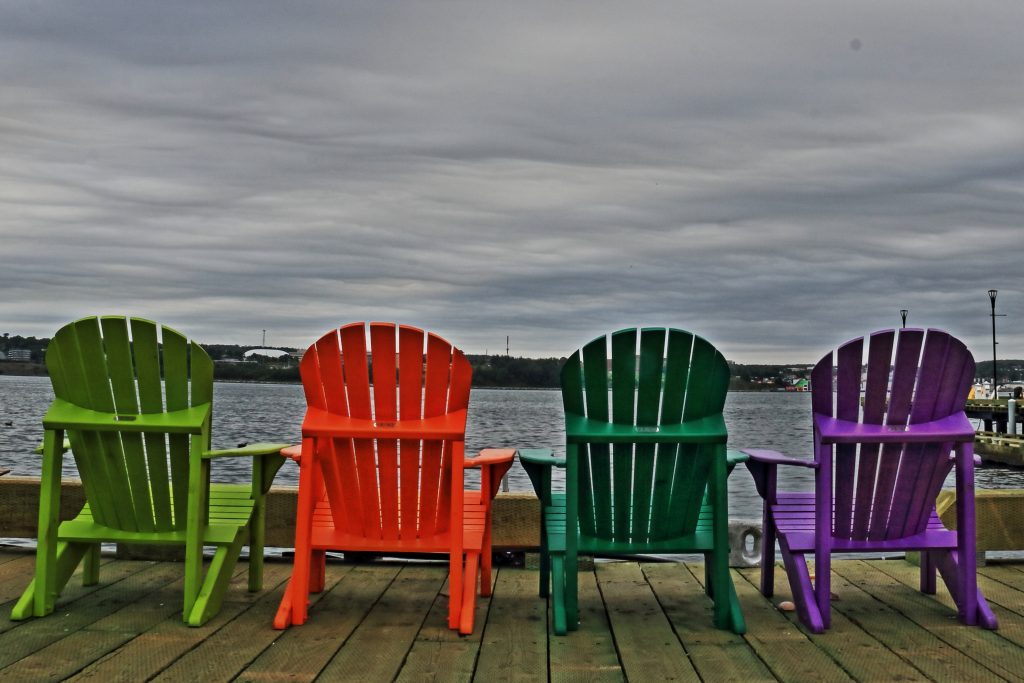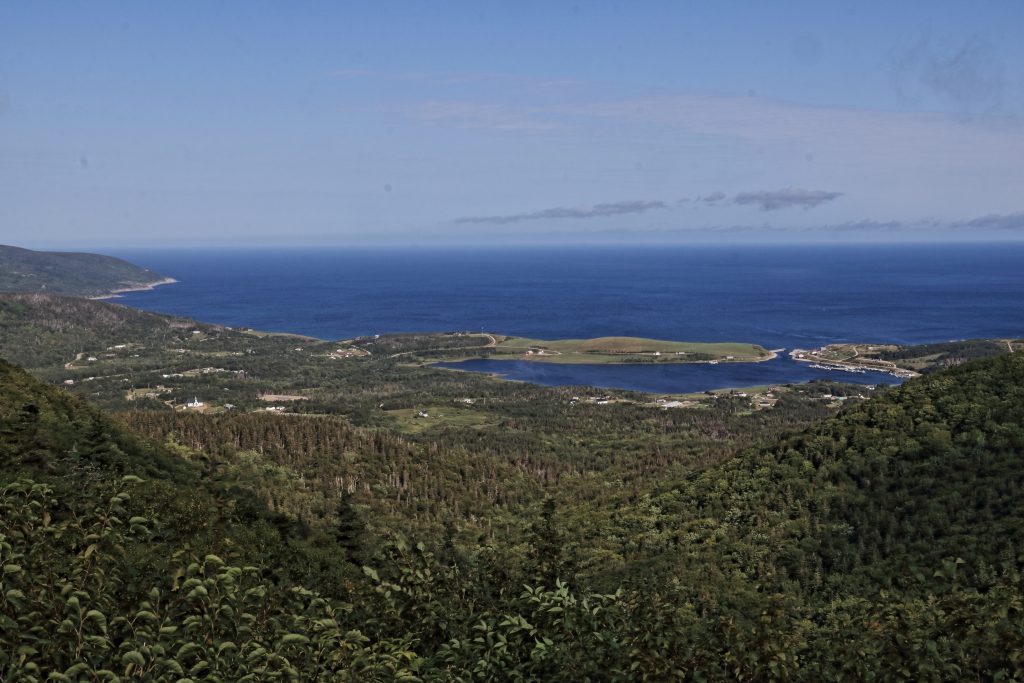‘New Scotland’. Spend a bit of time overlanding Nova Scotia and it’s not hard to see why the early settlers gave it the name. The cracking coastal scenery bears more than a passing resemblance to its Scottish namesake. But we didn’t find just great scenery in Nova Scotia… we found a bit of education too. Things we never learned at school (or maybe we did but have long forgotten). Anyone on a ‘world-schooling’ trip with kids wanting a lot of great scenery and a bit of beach camping on the side, then overlanding Nova Scotia is your thing!

Tyre miles
We’ve set quite a pace over the last few weeks, doing around 12,000 km since we left BC six weeks ago (across the Prairies, Ontario/Quebec and NB/PEI) . It’s waaay faster than we would ordinarily choose to do overlanding. But before we know it, Mr Snow will turn-up and we really want to explore Atlantic Canada before that chap arrives. This pace of travel inevitably takes its toll on Cuthbert’s tyres and Marcus keeps a close eye on the tread-wear. The Michelin XZLs wear better on dirt than tarmac, but we haven’t done many dirt roads since the Prairies. We try to take back-roads when we can, and Marcus does tyre rotations to off-set any uneven wear.

Fundy Bore
The dedicated Cuthbert follower may recall from our previous blog: i) what a tidal-bore is; and ii) how we tried and failed to be impressed by the tidal bore on the New Brunswick side of the Bay of Fundy. Not that it’s New Brunswick’s fault or anything… we simply went to the wrong place at the wrong time and proved the saying: ‘failing to prepare is preparing to fail’ 😉.

Our more recent investigations revealed that South Maitland and Truro are the top-spots in Nova Scotia to witness the bore-wave, and that 22nd/23rd August would be an optimum moment in the lunar cycle. Other helpful little nuggets we learned are that these spots sit on different rivers flowing into the Bay of Fundy but are just 20km apart by road. Due to the shape of the rivers, the two bore-waves look quite different and happens around 1½ hours apart.
And so it came to be, that we (eventually) witnessed not one but two tidal bore-waves. First, at South Maitland where the wide bore-wave comes slowly up-stream. It’s popular here for trippers to ‘ride’ the bore-wave in boats. Once we had seen it all here, we jumped into Cuthbert and hot-footed over to Truro to see the wave there. Here the river is narrower and the wave slightly more dramatic.
So does the wave live up to expectations? Well, let’s not set the bar too high here! It’s no tsunami or ‘Hawaii 5-0 Style’ breaker knocking thrill-seekers off their feet. But if you remember that the river is meant to be flowing towards the sea with some power, yet the tide is sufficiently strong to reverse that flow back towards the river’s source, then you might just consider the tidal bore-wave to be a cool freak of nature. We took a snippet of video so you can make up your own mind whether it’s a worthy tidal-bore, or just plain boring.
Acadia
Another bit of education in Nova Scotia is learning about the history and fate of the Acadian people here. Their story is waaay too long, complex and interesting to document in a chirpy travel blog. Mr Google can assist you with an enquiry if you so choose, or you could go to the historical site of Grand Pré to learn about them like we did 😉.
Grand Pré is the spot where many Acadians were ruthlessly expelled from Canada by the British in the 1750s. The British and French were at war over Canada at the time and the Acadians’ crime was to refuse to swear allegiance to King George III. Given that they also refused to swear allegiance to King Louis XV and wanted instead to remain independent in the war, one might reasonably conclude that allegations of a crime were tenuous to say the least. But we Brits aren’t judged by history to have been particularly ‘reasonable’ in that era are we?
Halifax
This trip isn’t the first time we’ve been to Nova Scotia. Having been to the Halifax area on brief trips before, we remember down-town Halifax as a fun place – a place we’re keen to re-visit and see how it has changed.
Around Halifax and ‘mainland’ Nova Scotia
After more years ago than we care to remember, we can confirm that Halifax is indeed still a lovely city with a cool vibe in the down-town waterfront area. We enjoyed sight-seeing and ate lots of yummy lobster. There are also a few great museums that we enjoyed and are worthy of a bit of an educational mention here…
Maritime Tales
First, the Maritime Museum. On the Atlantic coast, Nova Scotia obviously has a long history and connection with the sea. Halifax was one of the places to which survivors (and sadly corpses) from the Titanic were brought in 1912. But another equally tragic naval disaster happened here which has gained much less international attention.
On 6th December 1917, the fully loaded Mont-Blanc munitions ship was manoeuvring in the foggy Halifax harbour. The Imo was also finding its way in the fog and collided with the Mont-Blanc. The impact created sparks, leading to a fire, then an enormous explosion resounded beyond the city. Debris was thrown over 5 km from the dock and windows shattered up to 100 km away. Hundreds died, streets set on fire and much of the city was razed to the ground. The museum shows pictures and tells harrowing accounts which were largely lost in the mire of a million stories of European destruction and suffering in the 1914-18 War.
Loaf Tales – Pier 21
Pier 21 is a museum on the exact spot where countless migrants arrived off a tough trans-atlantic voyage from Europe for processing into Canada in the mid-20th Century. The stories of the people who continue to contribute to what Canada is today, are varied and interesting. One slightly trivial account from the presentation in the museum struck a chord with us.
Now… before we explain this point… regular Cuthbert readers will (hopefully) agree that we have very little, if anything, derogatory to say about Canada generally. We’re big fans… really. But when the presenter in the museum explained that the migrants of the 1940s and 50s found the bread here “not to their taste”, we looked at each other and laughed! European immigrants of the time apparently found Canadian bread to be “bouncy, like cotton wool but sweet”. No change there then! After 70+ years, it’s still the same!
Sorry Canadians. You are fabulous people in a fabulous country, and we love you to bits. But your bread, by European standards, is dreadful (okay… there are exceptions, but save for Cobbs chain and the German bakery in Whitehorse, they’re pretty rare). Our experience of Canada is obviously very different from those mid-century immigrants seeking a better life. But we are totally with them on the bread-thing. Immigrant children apparently preferred to use the bread as a pillow to sleep on rather than eat it… now there’s an idea 😉
Cape BretonIsland
Over a short causeway north from ‘mainland’ Nova Scotia is Cape Breton Island. It’s said to be the most beautiful part of the province, and you know what? It’s true! The much-driven Cabot Trail is a photogenic circular route of jaw-dropping cliff, after jaw-dropping beach, after jaw-dropping fishing harbour. We took several days to drive the … km circuit and loved it all. We enjoyed the detour route up to the Meat Cove area, although (maybe due to many gushing reports raising our expectations to an unfeasibly high level) we were less impressed by Meat Cover itself than we expected. It’s a pretty enough place, but we’ll agree-to-differ with anyone who says it’s the best that Nova Scotia has to offer.
We could ramble on about Cape Breton Island with a load of blah, blah, blah on the beauty of it all. But we’ll go with the ‘picture paints a thousand words’ theory here and let you see for yourself.
New World Comms
Our final piece of Nova Scotian ‘they-never-taught-me-that-in-school’ education has a geeky-sciencey leaning. It comes from the brilliantly presented museums of Alexander Graham Bell and Guglielmo Marconi. It turns out, these two giants of communications history both had significant connection to Nova Scotia.
First, we visited the Nova Scotian pad of A.G. Bell on Cape Breton, which he said reminded him of home in Scotland. It seems from the museum that there was a bit more to ‘Old Bell’ than the invention of the telephone for which he is most famous. Here on the Island, Bell and his chums spent years developing early aircraft and hydrofoil water-craft on the local lake. Bell and his wife were also pioneers in eco-friendly living, way ahead of their time on that.
Down in mainland Nova Scotia is a museum to the Italian genius of transatlantic radio communications. Once Marconi believed he’d created the ability to transmit over the distance, he came to Canada to test his theory. In 1901 his first success was a transmission of the letter ‘S’ from Cornwall in England to Newfoundland, but it was a success he couldn’t immediately repeat. After a bit more work, in 1902 he scrounged some funding and settled near Sydney in Nova Scotia. From here he transmitted the first continuous, full-sentence communication to England. Ta-dah! No more waiting weeks to pass a message by ship!
They love a ‘lighthouse reference’ in Nova Scotia
Bell and Marconi were each doing their stuff around the same time, essentially just down the road from each other in Nova Scotia. But despite their written correspondence, it seems they never actually met in person. Their combined legacy started a chain leading to the magic of inter-webbery by which you can read these very words today. We missed learning this kind of human-history stuff at school, but we’re getting around to it now with an overlanding education. Better late than never 😊
A Life on the Ocean Waves
‘Yo-ho-ho and a bottle of rum… a life on the ocean waves’. Okay…. a five hour ferry from Nova Scotia to Newfoundland isn’t quite a life at sea, but we’re excited to set sail to our 12th province of Canada. We’ve heard great things about Newfoundland, but it has a lot to live up to. Nova Scotia has set the bar very high! Tune in next time if you’d care to learn how overlanding Newfoundland compares to overlanding Nova Scotia …

















